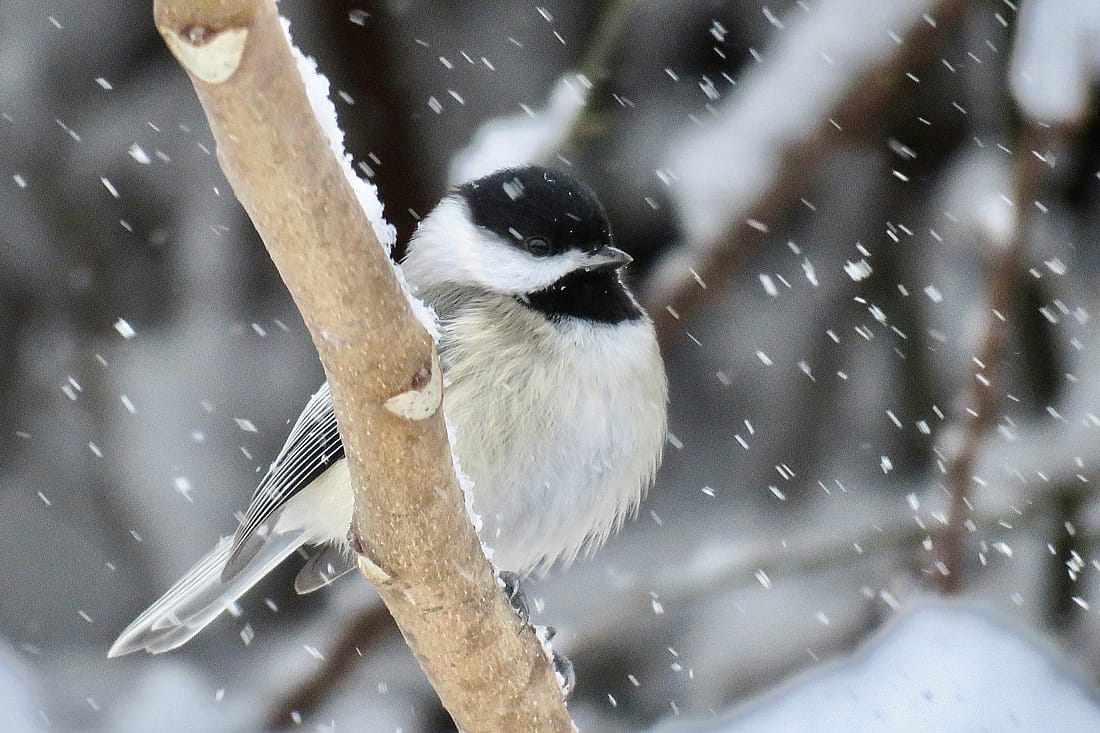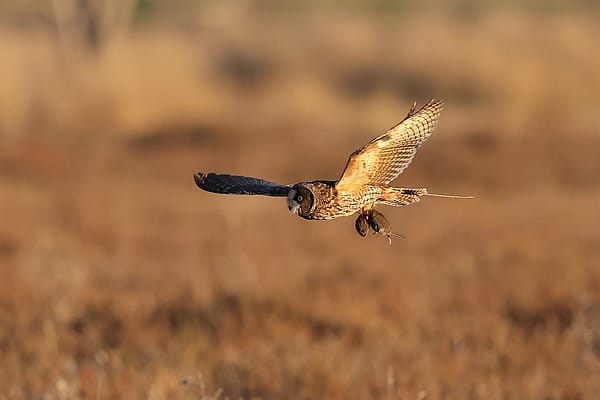
Black-capped Chickadees, the Birds Whose Brain Changes

If you love birds, especially if you feed birds, then hopefully you are familiar with Black-capped Chickadees (Poecile atricapillus). These are cute, little, non-migratory birds which live year-round from New England to the West Coast and as far south as New Mexico and Georgia. I enjoy watching them as they quickly flit back and forth from my sunflower seed feeders to our blue spruce. Here in Wyoming, and in many higher altitudes areas of the western states, there is another similar looking bird known as the Mountain Chickadee (Poecile gambeli).
Black-capped Chickadee Calls
You will often know chickadees are around as they noisily call out their names- “Chickadee-dee-dee” or maybe “Chickadee-dee-dee-dee.” This is their most common call. Take note of the “dees.” How many do you hear? Ornithologists tell us that if chickadees become alarmed, they will add more “dees.” If you hear more than 5, the bird may be advertising danger.
To hear this “dee-dee” call and others as well as what they mean, check out this video.
“What are Black-capped Chickadee Calls, Sounds, and Song used for?” https://www.youtube.com/watch?v=8QB4pxjEQF4&t=0s
Favorite Foods
Black-capped Chickadees have a varied diet. In the winter, they will eat seeds, berries, and other plant matter. The other half will be foods such as insects (especially their eggs and pupae), spiders, suet, bits of meat, and fat, even chipping off pieces from frozen carcasses.
During the remainder of the year spiders, insects, and other meat sources make up as much as 80 – 90 percent of their diet.
When visiting feeders, chickadees prefer sunflower seeds. However, they do not eat the seed whole, rather will peck out a hole in the shell, enlarging it as needed, then chip out tiny pieces of seed. In addition they will feed on peanuts and suet. If mealworms are available they will also enjoy those as a high-protein snack.
Caching
As I watch chickadees fly to my feeders, quickly snatching up a seed and swiftly disappearing into our blue spruce, I wonder if they are feeding or caching their prize. “Caching” is a term used to describe a behavior for animals that store food for future meals. In the winter, these caches are a necessity for chickadees since they eat more than 35 percent of their body weight every day.
Each seed gathered is placed in a different location. It is believed that chickadees not only store huge amounts of seeds, but they also have a good memory as to where it is located. According to Cornell’s All About Birds, chickadees can remember thousands of hiding places. While studying Black-capped Chickadees, Dr. David Sherry found that chickadees could remember where their caches were for at least 28 days after storing the food.
If you are interested in finding out more about caching, visit my blog, “Caching in Birds: What it is, the Why and How” here: https://centerofthewest.org/2021/06/06/caching-in-birds-what-it-is-why-and-how/
How Do Chickadees Survive the Winter?
In the winter and fall, birds may eat more in order to build up body fat. This fat adds to their body insulation and creates an additional energy source. In addition, they will fluff up their feathers to maintain body heat. Coupled with caching to ensure a good food supply, chickadees will still continue to forage for seeds and other food sources.
Importantly, Black-capped Chickadees can drop their body temperature and enter into a controlled hypothermia (sometimes called regulated hypothermia). Chickadees may use controlled hypothermia to drop their temperature as much as 22 degrees Fahrenheit below their daytime body temperature. This adaptation helps chickadees to conserve nearly 25 percent of the energy they would otherwise use every hour to maintain its normal 108 degree body temperature.
Chickadees Undergo a Seasonal Brain Change
For me the most astounding fact about chickadees is what happens with their brains. Every fall, generally in October, Black-capped Chickadees undergo a change in their brains. Flying around in an area up to 10 square miles, they gather hundreds, even thousands of seeds to cache. Of course this does no good, if one can’t remember where the seeds are hidden.
According to professor Diane Lee at Cal State University, every fall the part of a chickadee’s brain responsible for remembering where things are expands in size by approximately 30 percent. This growth is in the number of neurons, or brain cells in the hippocampus. This cell growth was first described by neuroscientist Fernando Nottebohm in 1994. Other scientists did not at first believe this could happen. However further research has proved this is true.
In addition, when winter is over and the old information is no longer needed, the brain shrinks back to its smaller size, erasing the unwanted memory. These forgotten memories will be replaced with new memories the following fall as they again grow more brain cells and go about the business storing food.
In Closing
For the most part, Black-capped Chickadees are a bird that people welcome to their feeders. They do well living beside humans and may even move into a bird house if you have one that suits their needs. Furthermore, if they are familiar with you, chickadees may eagerly take sunflower seeds from your hand. This is especially true during their prime caching season.
We used to spend summers and sometimes early fall in the Upper Peninsula of Michigan. We had a lot of chickadees living in our area. In the fall we could simply hold out our hands with sunflower seeds in them and the chickadees would come right down and land on our fingers. Thereupon, they would carefully choose a seed, picking up and dropping a few to decide which was best before carrying it off. Sometimes there would be a line of chickadees perched on a tree branch waiting their turn. They never challenged each other, but would wait in line, dropping down one at a time.
Photos:
Opening photo Black-capped Chickadee by Tom Murray, Attribution-NonCommercial 2.0 Generic license
Chickadee with catepillar by Tom Murray, Attribution-NonCommercial 2.0 Generic license
Photo of a Black-Capped Chickadee on a dry sunflower by Tony’s Takes, Attribution-NonCommercial-NoDerivs 2.0 Generic license
Chickadee in Winter by Cam Miller, Attribution-NonCommercial-NoDerivs 2.0 Generic license
Black-capped Chickadee perched, by Tom Murray, Attribution-NonCommercial 2.0 Generic license
Black-capped Chickadee on Bird House by Colin Durfee, Attribution 2.0 Generic license
Black-capped Chickadee on a hand, by Judy Gallagher, Attribution 2.0 Generic license
Written By
Anne Hay
Anne Hay has a Bachelor's degree in Elementary Education and a Master's in Computers in Education. She spent most of her working years teaching third grade at Livingston School in Cody, Wyoming. After retiring she began doing a variety of volunteer work for the Buffalo Bill Center of the West’s Draper Natural History Museum. Anne loves nature and has a concern for the environment. She believes that educating the public, so that they will have a better understanding and appreciation for the natural world, is very important. Because of this belief, volunteering at the Center is a perfect fit. She spends time in the Draper Lab, observing eagle nests for Dr. Charles Preston’s long-term research project on nesting golden eagles, writing observation reports of raptor sightings in the Bighorn Basin, and working with the Draper Museum Raptor Experience. Anne states that, “Having a bird on my glove, is one of my all time favorite things in life.”

















